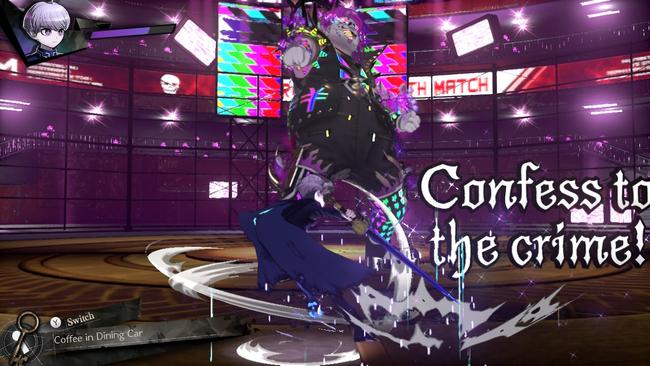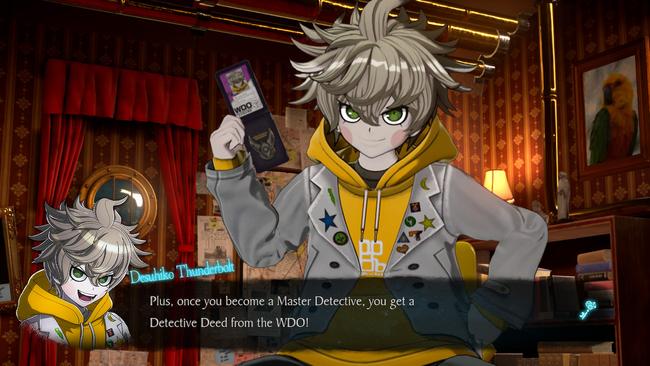
Master Detective Archives: Rain Code Review
Kazutaka Kodaka is best known for his work as the lead writer behind the Danganronpa series. As a fan of the mystery adventure franchise, I was excited to see what Master Detective Archives: Rain Code was all about. A collaboration between Kodaka’s own studio and Spike Chunsoft, it has Danganronpa's distinct art style as well as its wacky, over-the-top dialogue. With an incredible nail-biting story, a charismatic cast of characters, and a fantastic presentation, Master Detective Archives: Rain Code is one of the best mystery adventure games in recent years.
Rain Code takes place in Kanai Ward, a city that experiences never-ending rain. With a decidedly anime-noir atmosphere, I was immediately taken aback by the game’s breathtaking visuals and art direction. Kanai Ward looked and felt like a real metropolitan city, with constant rain and cloudy weather allowing the city’s various neon lights to stand out against the melancholy backdrop. However, while the graphics look great when the Nintendo Switch is docked, they can look rather murky when playing in handheld mode.
Kanai Ward’s mood reminded me of the days when I’d sit and work on my computer in a coffee shop while listening to music and turning my head to look out the window to see the rain pouring down. Despite the gloomy weather, there was a sense of calm and sereness to it all, and Rain Code’s atmosphere recreated those exact feelings. The soundtrack also adds ambiance to the setting, filled with jazzy trumpets and slick guitar strings. But underneath all of the beautiful lights and sounds is a sinister secret hiding in the dark underbelly of Kanai Ward. That’s what the main protagonist, Yuma Kokohead, set out to uncover.

As part of the World Detective Organization, and a trainee detective, Yuma has to solve several murder mysteries that take place throughout the game’s story. While each one feels like an isolated case, the small intricacies between them eventually connect to Kanai Ward’s larger history. It’s a real page-turner and kept me invested all the way to the very end—I just couldn’t help myself but continue to the next chapter.
Yuma’s inexperience and naivety lead him into some really sticky situations; usually, he ends up cornered with guns pointed at his head. However, he’s not alone. His trusty ghost partner, Shinigami, haunts him to help out during his investigations.
While Rain Code has a wonderfully memorable cast of characters overall, Shinigami is definitely the star. She’s a mischievous death god who teases Yuma constantly, but she always wants to lead him to become a better detective by pushing his boundaries. The dynamic between the two characters is largely what makes Rain Code’s dialogue so entertaining. He freaks out at the victim’s corpse while she glees in delight.
In the gameplay sections that accompany these dialogue scenes, I love the way Shinigami simply decides to hang around the immediate area when she and Yuma are together. She essentially follows him around like a Pokemon. For example, when exploring a high-rise building, she just chills on the nearby couch by herself until I run past it and she gets up to follow me again. This attention to detail really adds a lot of personality to her.

Investigations act out quite similarly to how Danganronpa had them. Yuma can walk around crime scenes and examine evidence in order to find out who the culprit is. I appreciated that this is ultimately quite a straightforward process, as Yuma will mention that he’s covered every possible spot and you can choose to end the investigation there.
Each chapter’s investigation implements the "Forte" special ability of one of Yuma’s fellow detectives. For instance, Desuhiko Thunderbolt’s Forte is the ability to put on near-perfect disguises. He helps Yuma put on different outfits in order to infiltrate a school and gather testimonies. Some characters aren’t on good talking terms with each other, so Yuma has to figure out which disguise to put on when talking to specific characters; this was an incredibly clever way of gathering evidence.
Most of these Fortes are used in fun and interesting ways. However, the only time I felt like a Forte wasn’t implemented as well was in Chapter 3, where Fubuki Clockford’s cool time rewind gimmick ended up just being an overabundance of quick-time events, was felt boring and unimaginative to some of the other chapters. Additionally, there aren’t any accessibility options to even adjust the speed of QTEs, so the more time-sensitive ones quickly became annoying.

After investigations, Yuma and Shinigami go into the Mystery Labyrinth, a separate dimension that contains the manifestation of the current mystery itself in the form of a giant castle. This is also where Rain Code’s gameplay is most similar to Danganronpa’s. Shinigami turns from a ghost into a goth girl and supports Yuma in cutting down Phantoms, which are physical manifestations of his adversaries.
The main mini-game is called the Reasoning Death Match. Here, evidence collected throughout the investigation forms into Solution Keys, where Yuma slots into his Solution Blade to strike down floating statements from Phantoms. It’s very similar to the Rebuttal Showdown mini-game from Danganronpa.
Yuma can move side to side or duck and jump to avoid attacks coming his way, and then hitting the correct statement with the right piece of evidence triggers his “that’s it!” moment, progressing the Mystery Labyrinth. Reasoning Death Match is a really engaging and fun way to add some combat-like elements to the game. There are some other mini-games as well, such as the Shinigami Puzzles, where Yuma has to shoot at letters on a rotating barrel to spell out the answer to a question. These add a variety to the selection of mini-games you’ll encounter.
Yuma also has a skill tree where you can spend Detective Points (DP) to upgrade his abilities. These include skills such as being able to dodge attacks quicker or simply just increasing his overall stamina. DP can be earned by examining random objects around Kanai Ward that trigger fun, short conversations between Yuma and Shinigami. Completing side quests rewards DP as well. The sidequests are usually brisk and add some interesting worldbuilding to Kanai Ward, so they’re worth doing. However, sometimes they can take longer than expected to complete due to the game’s long load times, especially when fast traveling between areas.

What I love about Yuma and how the labyrinths play out is that he’s constantly challenged on the morals of exposing the truth. Would he still reveal who the culprit is, even if he sympathizes with their actions? What if revealing the truth leads to even more despair later? Without getting too detailed to avoid spoilers, certain dilemmas really test Yuma’s resolve, giving him substantial character development throughout the adventure.
Master Detective Archives: Rain Code is a wild ride from start to finish. There were some twists in the mystery I wasn’t expecting and some that I saw coming. Despite a short lull in the middle section of the game, it still results in an excellent story told with a colorful cast of characters. Kanai Ward itself is such a beautiful place too. Like how the rain never lets up in the city, the suspense never lets up in Rain Code.